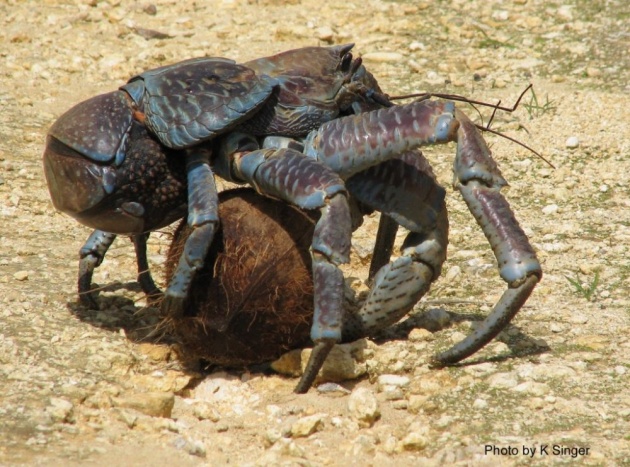Giant Coconut Crab

With the exalted title of the largest land based arthropod in the world, it's a wonder that the Giant Coconut Crab doesn't get more press than it does. These animals are generally nocturnal and live in many coastal and forest regions of Indo-Pacific islands. Including the Western and Central Pacific Ocean, The Indian Ocean and the seas in the area of Indonesia. Some of it's "island names" are the Robber Crab or Palm Thief because of it's reported habit of taking anything it can use, specifically shiny items. But they get their common name from their ability to climb Coconut Palm trees, clip off the Coconuts, return to the ground, peel the husk fromt he coconut, and hammer them open by dropping it repeatedly on rocks, or banging them open with their large claws. The rest of their diet is primarily fleshy fruits, nuts and seeds. Though they are Omnivores and will consume other items as well.
Coconut crabs have a body length of about 16 inches, a leg span of 3 feet, and can weigh up to 9 pounds. Though there are accounts of them reaching upwards of 6 feet across and weighing up to 30 pounds. They can also live more than 30 years.
Coconut Crabs can't swim, even smaller crabs drown in water, though they require water to survive. They have an organ called a branchiostegal lung, that is explained to be something in between gills and lungs. This organ allows the crab to take oxygen out of the air, but also has to be kept moist to function. So it is more likely to see them in daylight during a rain storm as the moisture allows them to breathe more easily.
Though an adolescent has many predators, the only danger to a fully grown Coconut Crab are Human Beings. As the crab is a delicacy as well as an aphrodisiac in Southeast Asia and the Pacific Islands. Particularly if the eggs can be harvested from inside the female Coconut Crab.



